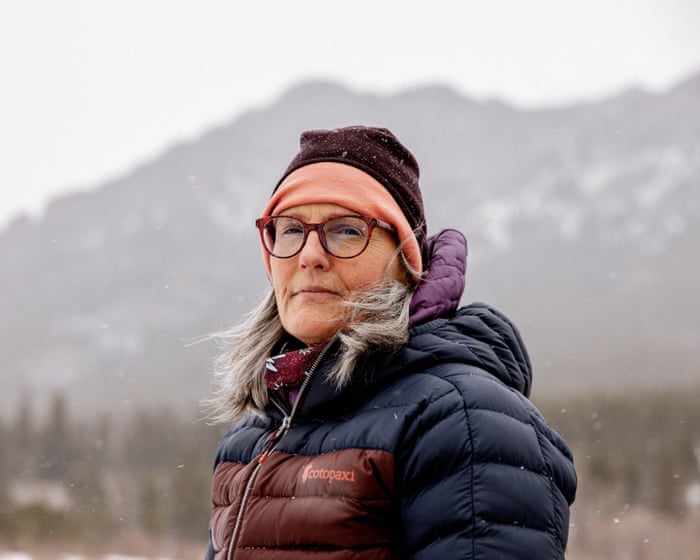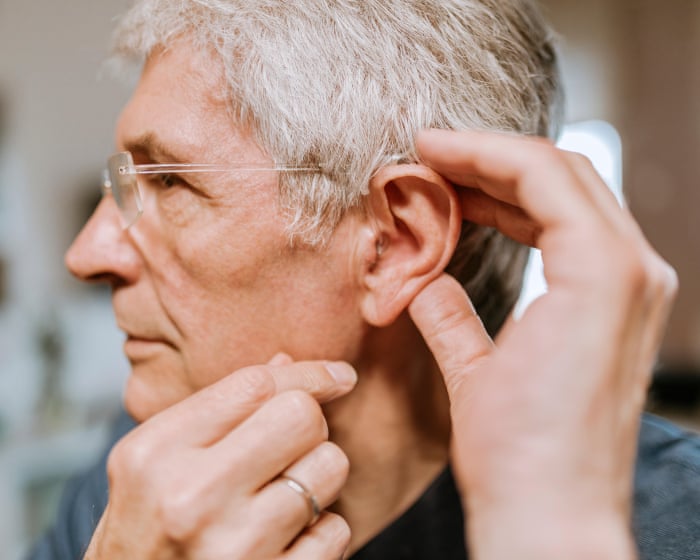In May 1982, Jean Muenchrath and her boyfriend Ken reached the summit of Mount Whitney, the highest point in the contiguous United States. They were finishing a month-long, 223-mile ski and hike along the John Muir Trail through California’s Sierra Nevada mountains. Though the journey had been tough—with broken equipment, bears, and avalanches—it was also thrilling. At 22, Jean was fit, strong, and an experienced hiker who had skied since childhood and worked as a park ranger in Montana. She and Ken, whom she met in college, had trained with many smaller adventures for this trip.
As a storm rolled in, they changed their planned route to a steeper descent. Using their ice axes to anchor themselves in the snow, Ken lost control and fell 800 feet. Jean had to push aside her fear for him and concentrate on her own climb down. When she reached him, he was miraculously unharmed. His backpack had come off during the fall, and he climbed down to a ledge to retrieve their rope.
Exhausted and with daylight fading, Jean considered whether she needed the rope to continue. Seeing that Ken had managed easily, she threw her skis down the mountain to reduce the hazard and removed her mittens for a better grip. But she soon realized the climb was much harder for her. Carrying a 15kg backpack and wearing bulky ski boots, she struggled to find handholds, especially since she was shorter than Ken. Cold, hungry, and shaken from his fall, she found herself stuck—unable to climb up or down. Her arms trembled until she could no longer hold on.
“I felt desperate,” she recalls. “My last thought was, ‘God, don’t let me fall.'” Before blacking out, she heard her head hitting the rocks. Ken watched her plunge down the cliff, her ice axe sparking against the granite. “My world went dark the moment I fell,” Jean says. “I felt no pain, just heard the impact. There was no life flashing before my eyes—just nothing.”
When she came to, Ken was pulling her through the snow. She tried to walk but kept collapsing. They managed about half a mile before finding a spot to camp. “I knew I was badly hurt,” Jean explains from her home in Colorado. Now 65, she remains cheerful and energetic, even when recounting the ordeal. She had head and buttock wounds, a fractured spine, a broken pelvis, and internal bleeding. “I was weak and disoriented, just trying to stay upright.”
As they set up camp in the fading stormy light, a shaft of golden sunset broke through.The sun broke through the clouds and illuminated Mount Russell. I remember thinking, ‘This might be the last thing I see before I die.’
That night in the tent, Muenchrath suddenly felt wide awake. “I had what I call my visit from death, almost like a presence.” She sensed a heavy shadow hovering above her body, not threatening but calm. “Looking back, I think I was feeling my life force beginning to leave my body, and that’s when I promised myself that if I made it to morning, I would pursue my biggest dreams.” For her, that meant traveling to the Himalayas. “For some reason, I told myself, ‘Just make it to morning, and everything will be fine,’ but obviously I needed to survive much longer.”
Muenchrath had nicknamed their tent “the coffin” because of its shape and size—they had to crawl to get inside. The name now felt eerily fitting. “It was very cramped and dark because it was snowing heavily. The tent was being buried under the snow.” Muenchrath was in severe pain but had no room to move or adjust her position. She repeated to herself again and again: “I’m going to live.”
They stayed in the tent for two full days and three nights as the storm raged outside, trying to decide what to do. It was too dangerous for Ken to leave Muenchrath alone on the mountain to get help. They had to descend together, carrying their gear, since they couldn’t reach safety in one day.
It seemed impossible, but Muenchrath was determined to leave. “When we packed up to start our journey out, I didn’t look back at the camp. I didn’t want to see that place. I only wanted to look ahead.”
She was weak, injured, and could barely move. She faced a rocky, snowy mountain pass, a 4,800-foot canyon, and hazards like fast-moving meltwater and dense vegetation as they descended. It must have seemed unimaginable. “Yes, and I was carrying a 15kg backpack on my broken spine and pelvis, and I had developed gangrene in my butt from the injury.” She gives a slight laugh. “It was daunting, but if I didn’t focus on the distance or how rough the terrain was—and it was still winter at higher altitudes—I just took it one step at a time. Sometimes I’d collapse, then take a step. We were going to die if we didn’t try—and if I was going to die, I was going to die doing everything I could to live.”
Patches of snow had melted, creating hidden holes that caused her to fall, sending pain shooting through her broken body. At one point, she crawled across the snow to relieve her back.
The worst part was crossing a massive glacial trough where the snow was thigh-deep. She had to lift each foot, ignoring the pain in her pelvis and back, before planting it again in the deep snow. “That was excruciatingly painful, and you knew you had to do it over and over. I remember praying a lot. I would visualize the Himalayas, thinking, ‘This is why you’re going through this—you’re going to see those mountains.'”
Years later, when I began to experience chronic pain, I sometimes wished I hadn’t survived. It was both terrifying and agonizing. “I knew my back was broken, though I didn’t know all the details, and I was really afraid of severing my spinal cord, becoming paralyzed, and then freezing to death in a snow hole.”
Exhausted, they camped that night. The next day, they finally reached a trail. By then, she says, “I was collapsing left and right, literally face-planting in the dirt and then getting back up. I was walking like a staggering drunk because I was so weak. Ken h…I had taken my backpack at that point. I would think, ‘I’m so close, but I’m just not sure I can make it. I could just die right here.’ But every time that thought popped into my head, I balanced it with, ‘You’ve got to go see the Himalayas. Get up and get walking.'”
Ken carried her the final stretch to a car park at the end of the trail. When they arrived, knowing they were close to help, the pain hit her. “I think I had been suppressing it mentally without realizing it.” She burst into tears for the first time since the fall five days earlier. She hadn’t let herself cry until then, “because it would have been so overwhelming—I think I would have just died or couldn’t have made it.”
Muenchrath was still in danger: she had lost a lot of blood, was exhausted, and in shock. Ken flagged down a man who took them to the hospital, where she was told her spine was broken in several places, her tailbone shattered, and she had fractures to her pubic bone and hip. She had to have the gangrene in her buttock removed, and her bladder was damaged, so she needed a catheter to urinate.
Muenchrath spent the next few months recovering in bed at her mother’s house. Her doctors told her she probably wouldn’t hike again, which only fueled her determination to do so. Within a couple of years, she was almost back to normal and was hiking and skiing with Ken again. When he was offered a job as a park ranger in Colorado, they moved there and got married—and Muenchrath also went on to work as a park ranger.
They never talked about what had happened on the mountain, and Ken urged her not to tell anyone else. “I never understood why that was,” says Muenchrath. “Maybe he felt guilty, which he didn’t need to. I’m the one who made the poor choice. Or maybe he was embarrassed.” They were together for more than 25 years and had many other adventures before they separated in 2003, but the silence around the accident became a “sticking point.” “I really shouldn’t have put up with that, and I do think it held me back in my healing. I think that’s why I was able to move forward more after we divorced.” Ken died in 2013.
Only two years after the fall, Muenchrath did see the Himalayas—armed with disposable catheters (her bladder was still damaged) to see her through the seven-week trek. Then she started running guided tours in Nepal.
By the late 1990s, she was experiencing chronic pain as a result of her injuries, and her body and life seemed to be falling apart. For the next couple of decades, the pain came and went—sometimes she was unable to hobble even a few feet and was confined to bed for months. “It was a big struggle,” she says. “I did have times where I would just curl up in bed and bawl, and feel very hopeless, and there were times I even wished I hadn’t survived.”
Just as she had kept herself going when she was in that tent on the mountain, Muenchrath trained her mind. On her trips to Nepal, she became interested in Buddhism. She decided to turn those months in bed “into a meditation retreat, and that’s what I did. I did a lot of mantras, a lot of visualizations, I did a lot of compassion practice and thinking about others who were in worse circumstances than myself, because you think it’s all about you, but it’s not. I would think about the things I wanted to do so I could have some hope that I could get past this.” Friends helped, she says. “I learned to draw on Mount Whitney as a source of strength—you got through the worst, you can get through this next thing.”
She developed her own stretching and exercise routines, and…She was fortunate to find compassionate doctors who recognized her pain. She also started counseling, and her therapist suggested she write a book. Titled If I Live Until Morning (2017), the process proved very healing as it forced her to fully process her experience.
In 2013, Muenchrath returned to Mount Whitney with her partner, Paul, and a friend, Jonathan, both experienced climbers. The multi-day trip was partly to search for her abandoned skis, but also to confront her fears. At the site of their emergency camp, Jonathan noticed a ski less than 100 meters away. It wasn’t hers, she realized, but Ken’s. Picking up the broken ski, she looked up at the cliffs and stood where she should have died, feeling the past and present collide. Overwhelmed with emotion, she cried and screamed with rage and sadness, but it felt like a release—a truly cathartic moment.
Standing there, she understood that she had never truly forgiven herself. For decades, she had carried self-blame for a poor decision, but now she saw the need to accept it, forgive herself, and move forward. She also acknowledged her own strength in surviving such an ordeal, thinking, “You really pulled this off, even though it was nearly impossible. You did it.”
Frequently Asked Questions
Of course Here is a list of FAQs based on the scenario of tumbling down a mountainside and the struggle for survival
FAQs Surviving a Mountain Fall
Beginner Definition Questions
Q1 What does it mean to tumble down a mountainside
A1 It means youve had a serious fall likely rolling and bouncing off rocks and terrain which can cause severe injuries
Q2 Why is getting to safety so urgent in this situation
A2 Because exposure to the cold shock and untreated injuries can quickly lead to hypothermia and death
Q3 What kind of injuries might someone have from a fall like this
A3 Common injuries include broken bones sprains deep cuts a possible head injury and internal bleeding
Advanced Practical Questions
Q4 What is the first thing I should do after the fall stops
A4 First stay calm and dont move suddenly Check yourself for serious injuries If you can find a spot sheltered from the wind and cold before trying to move
Q5 How do I drag myself to safety if my legs are injured
A5 Use your arms and upper body strength to pull yourself along the ground You can crawl on your belly or use your elbows to drag your lower body Look for anything that can help like a strong branch to use as a crutch or a stick to pull yourself with
Q6 What if Im too injured to move at all
A6 Your priority then shifts to conserving body heat and signaling for help Curl into a ball to retain warmth cover yourself with anything available and use a whistle mirror or your phone to alert rescuers if you have them
Q7 How do I choose which direction to drag myself
A7 Head downhill towards a water source or a trail as these are more likely to lead to help Avoid going further into dense forest or up another steep slope
Q8 What are the biggest mental challenges in this scenario




